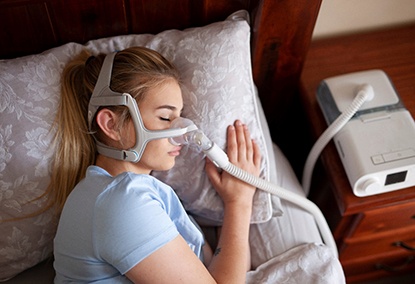OSA: A Common but Dangerous Disorder
Obstructive sleep apnea (OSA) is a sleep-related breathing disorder where your breathing stops or gets blocked multiple times each hour during the night due to a partially or fully blocked airway. It's estimated that around 22 million Americans are affected by this condition, and shockingly, 80 percent of those who might have it aren't even aware. Our team at Covington Sleep Center is dedicated to providing safe and effective solutions that can enhance patients' well-being. By addressing OSA early on, we can help people enjoy a higher quality of life. To learn more, continue reading or set up an appointment with us!
What Causes Obstructive Sleep Apnea?

Obstructive sleep apnea is primarily caused by an airway that gets blocked or partly blocked. When the muscles in the throat relax during sleep, they collapse and create an obstacle, which hinders proper airflow. If breathing stops for about 10 seconds, the body's oxygen levels drop, prompting the brain to signal the body to wake up.
The impact of this process can vary based on how long someone goes without breathing. Some people may have subtle interruptions, while others experience more noticeable disturbances. In fact, many patients go through one or even hundreds of these episodes each night.
Possible Complications of OSA

Untreated sleep apnea can severely impair a person's daily functioning, leading to various serious complications such as:
- Increased Risk of Drowsy Driving
- Workplace Incidents
- Stroke or Heart Attack
- High Blood Pressure
- Diabetes
- Heart Disease
- Chronic Fatigue
- Moodiness and Irritability
- Weight Gain
- Bedwetting
- Loss of Libido
- Regular Headaches
When Should I See a Doctor?

Recognizing when it's time to consult a doctor might not always be clear, particularly if you don't have someone to let you know if you snore or stop breathing during sleep. However, if you or a loved one notices any of these concerns, don't hesitate to contact our team in Covington. We're here to assist you in setting up an appointment for a consultation, during which we'll determine the best plan of action.
Reach out to us if:
- Your loud snoring wakes others.
- You wake up gasping or choking due to interrupted breathing.
- You discover that you have breathing pauses while asleep.
- Chronic fatigue is affecting your daily activities, including work and driving.
Types of Treatment for Obstructive Sleep Apnea

Although dealing with obstructive sleep apnea might feel discouraging, the good news is that there are numerous treatment options available to improve your condition. Some of those include:
Oral Appliance Therapy
Known as the favored choice for those dealing with sleep apnea, its popularity stems from its ease of use, comfort, and portability. It’s a convenient solution with impressive outcomes! These appliances are custom-made for each person's unique oral and facial features, helping reposition the jaw to prevent the soft tissues from collapsing. As a result, the airway remains open throughout the night.
Continuous Positive Airway Pressure (CPAP)
The continuous positive airway pressure system (CPAP) stands as one of the most recognized and embraced methods for treating sleep apnea. This approach involves a mask, tubing, and a machine. The device, worn during sleep, maintains an open airway by consistently delivering air through the mask.
Combination Therapy
Combination therapy merges CPAP and oral appliance treatment, effectively decreasing the frequency of nighttime awakenings caused by interrupted breathing. The CPAP machine operates at a lower pressure setting (thanks to the oral appliance's airway support), reducing the noise level and potential disruption for patients. Moreover, people can experience quality sleep while traveling by using the portable oral appliance.
Surgery
Surgery is among the less frequently chosen options for treating OSA. Generally, patients can achieve lasting improvements through the solutions mentioned earlier. Nonetheless, if enlarged tonsils, adenoids, or other soft tissues are obstructing proper airflow, a surgical intervention might be essential to alleviate symptoms effectively.
